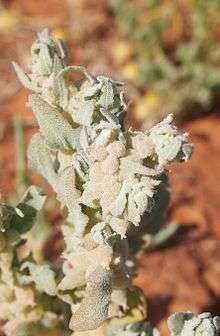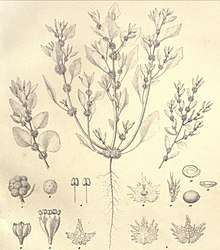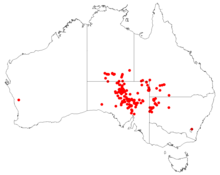Atriplex fissivalvis
Atriplex fissivalvis, commonly known as gibber saltbush, is a plant species in the family Amaranthaceae, subfamily, Chenopodioideae.[2] It occurs in the Australian states of South Australia, New South Wales, Queensland and the Northern Territory.[5][6][7][8]
| Atriplex fissivalvis | |
|---|---|
 | |
| Atriplex fissivalvis fruit | |
 | |
| from Mueller 1889[1] | |
| Scientific classification | |
| Kingdom: | Plantae |
| Clade: | Tracheophytes |
| Clade: | Angiosperms |
| Clade: | Eudicots |
| Order: | Caryophyllales |
| Family: | Amaranthaceae |
| Genus: | Atriplex |
| Species: | A. fissivalvis |
| Binomial name | |
| Atriplex fissivalvis | |
 | |
| Occurrence data from AVH | |
| Synonyms[4] | |
|
Haloxanthium fissivalve (F.Muell.) Ulbr. | |
Description
Atriplex fissivalvis is an annual monoecious herb 10–30 centimetres (4–12 in) high, which branches from the base.[7] The leaves (on a stalk of 5–10 millimetres (0.2–0.4 in)) are about 20 millimetres (1 in) long, with toothed or sinuate margins and an acute apex.[5][7] It flowers in clusters[2] in the axils of leaves,[7] from June to November (in the Northern Territory).[8] Fruiting is from June to November (in the Territory),[8] and the fruit is without a stem and enclosed in bracteoles.[7]
Distribution
In the Northern Territory it is found in the IBRA regions of Finke, MacDonnell Ranges, Simpson Strzelecki Dunefields, and Stony Plains.[8]
Taxonomy & naming
Atriplex fissivalvis was first described by Mueller in 1875.[2][3] The specific epithet, fissivalvis, comes from the Latin, fissus (cleft) and -valvis (-valved), giving "split-valved".[9]
Similar taxa
"Atriplex fissivalvis could be confused with A. lobativalvis, however the latter has fruiting bracteoles that lack appendages on the dorsal surface, are prominently keeled or have a raised area on the lower dorsal surface, have margins that are fused for over one-third their length, and has a preference for freshwater swamps and claypans."[8]
Conservation status
The Northern Territory lists this species as "Near Threatened" under the TPWCA act.[8]
References
- von Mueller, F.J.H. (1889) Iconography of Salsolaceous Plants I R.S. Brain, Government Printer, Melbourne.
- "APNI Atriplex fissivalvis". IBIS database. Retrieved 6 July 2018.
- von Mueller, F.J.H. (1875) Fragmenta Phytographiae Australiae 9(77): 123
- Govaerts, R.; et al. "Plants of the World online Atriplex fissivalvis". Board of Trustees of the Royal Botanic Gardens, Kew. Retrieved 6 July 2018.
- S.W.L. Jacobs. "New South Wales Flora Online: Atriplex fissivalvis". Royal Botanic Gardens & Domain Trust, Sydney, Australia.
- AVH Occurrence data: Atriplex fissivalvis
- "Atriplex fissivalvis F.Muell". Electronic Flora of South Australia Fact Sheet. State Herbarium of South Australia.
- "NTflora: factsheet for Atriplex fissivalvis". Northern Territory flora online. Northern Territory Government. Retrieved 6 July 2018.
- Stearn, W.T. (2004) Botanical Latin, 4th ed. pp. 413, 523. Timber Press, Oregon.